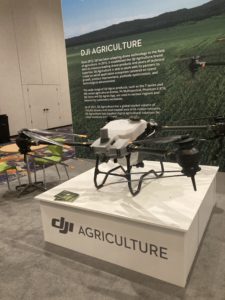 Drones are a major tool for agriculture, recognized by the World Bank and advocacy organizations around the world as a way of securing the global food supply. In Asian countries and elsewhere, spraying drones are widely used to apply fertilizer, pesticides and other products for more efficient farming. How are spraying drones bringing new opportunities to rural America?
Drones are a major tool for agriculture, recognized by the World Bank and advocacy organizations around the world as a way of securing the global food supply. In Asian countries and elsewhere, spraying drones are widely used to apply fertilizer, pesticides and other products for more efficient farming. How are spraying drones bringing new opportunities to rural America?
Taylor Moreland of AgriSpray Drones, speaking from DJI AirWorks, believes spraying drones like DJI’s new Agras model are can help more families farm together and give young people a way to stay in farming communities.
Growing up on a family farm, agriculture is a big part of Taylor Moreland’s life – but he always knew that in order to make a reasonable income, he wasn’t going to be able to immediately return to the family farm. After graduating from college, he started a seed business, and that’s when he first was introduced to drones, using the Phantom 4 for general crop scouting. Now, Moreland’s company is a distributor of spraying drones. Moreland is passionate about the opportunity that drone technology offers for young people who want to work in agriculture.
The Opportunity for Spraying Drones and Chemical Application in Agriculture
“Fungicides are getting much better,” says Moreland. “[Fungicide application] is almost a guarantee of improved production.” Corn and other row crops, however, are tall. Spraying fungicide over a tall crop is challenging and requires special equipment, etiher aerial or ground based. Throughout farming regions, there are only few operators who can apply these chemicals – and farmers have traditionally been at the mercy of manned aircraft operators or the owners of large ground-based equipment who have more business than they can handle.
“I learned that there was a supply and demand gap for application of fungicide in the midwest,” says Moreland. “And that’s when we started testing spraying drones.”
Farmers can’t fly a plane to apply fungicide themselves, but they can fly a sprayer drone. Using drones, however, means thinking differently. Time is always tight on a farm. An applicator takes the job away from the farmer, while purchasing a drone adds work. Moreland says that typically, 2,000 acres of corn can be covered by a manned aircraft in one day: while a drone can complete much less area in that time.
That can actually be an advantage. The 2,000 acres of corn were planted at different times – so when fungicide is applied all in one day, about 50 percent of the crop may be sprayed too early. Drones necessitate staggering the application, which allows the farmer to apply fungicide at the most efficacious time. The drone can also fly at night, when wind and temperature may be ideal for application. Sprayer drones are simply more effective than helicopters at applying chemical to row crops: better at getting to the edges.
New Businesses in Agriculture
Drones can be leveraged for better yields – and can provide many young people an opportunity to get back to a family farm and make a living. Sprayer drones can save farmers more than $30,000 in applications costs, and make fields more efficient. That’s enough to pay for an extra farm employee, says Moreland, and that employee can also help with harvest and more.
Moreland also believes that there is a tremendous opportunity for people who want to build a services business with spraying drones. The cost of the drone is so much less than ground application equipment, says Moreland, that the margins and the numbers are immediately compelling. “For about $50,000 and a truck and a trailer, people can start a spraying business,” he says. The demand is so great that the initial investment is generally recouped quickly.
Note on Regulations
Regulations are a hurdle, says Moreland: there are 5 things that the FAA requires for operators of spraying drones. Realistically, these certifications can take up to 9 months to acquire. (Other exemptions and regulations may apply. Contact the FAA for exact information.)
- Part 107 Remote Pilot License
- Drone registration for an aircraft over 55 pounds
- Class 2 medical certification
- AC-147 license (Agricultural Aircraft Operations)
- Exemption for operation of drones over 55 pounds
Taylor Moreland also runs a non-profit, called Frog Mobility, LLC – check out the mobility tools he builds for children with disabilities all over the world.
Read more about drones in agriculture:
- Drones in the Agriculture Sector: Five Ways Intelligent UAS are Helping Growers Meet Demand
- DJIs Agriculture Drone: AGRAS T20 for Agriculture Spraying
- Drones in Agriculture Worth More than $5 Billion by 2025
- Enterprise Scale: DJI Introduces New P4 Multispectral for Precision Agriculture and Land Management

Miriam McNabb is the Editor-in-Chief of DRONELIFE and CEO of JobForDrones, a professional drone services marketplace, and a fascinated observer of the emerging drone industry and the regulatory environment for drones. Miriam has penned over 3,000 articles focused on the commercial drone space and is an international speaker and recognized figure in the industry. Miriam has a degree from the University of Chicago and over 20 years of experience in high tech sales and marketing for new technologies.
For drone industry consulting or writing, Email Miriam.
TWITTER:@spaldingbarker
Subscribe to DroneLife here.







[…] post Agras Drones: Spraying Drones are Bringing Opportunity to Rural American appeared first on […]